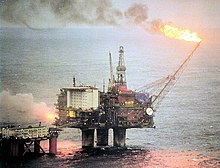Associated gas
Associated gas (also completely associated with petroleum gas ) is a fossil fuel gas that escapes from oil wells during oil extraction and the stratified oil during degassing . Depending on the production area, 25 to 800 m³ of gas are obtained from one ton of crude oil.
Since the associated gas can only be processed or transported with difficulty, it is often flared or injected back into the reservoir to maintain pressure . Despite international efforts, the quantities of flared associated gas have remained at a high level for many years. In official Russian figures quoted by the International Energy Agency , 15 billion m³ of the 56 billion m³ of associated gas produced in Russia annually were flared. After evaluating satellite data, the Global Gas Flaring Reduction Partnership (GGFR) announced that 140 billion cubic meters of associated gas were flared and blown off worldwide in 2011, which corresponds to around 4.2 percent of global natural gas production. While in Norway the associated gases may only be flared in exceptional cases and are subject to additional tax, in Russia and Nigeria, for example, associated gas is largely flared in an uncontrolled manner.
Origin and composition
Natural gas that is located in the vicinity of crude oil deposits can either occur independently of crude oil in the rock as dry gas or in dissolved form as wet gas .
Regardless of the source, the associated petroleum gas (possibly after its separation from crude oil) consists of a wide variety of ingredients. The main components are gaseous and vaporous hydrocarbons from methane to hexane , including isomers C 4 to C 6 . Every now and then you come across hydrogen. In addition, raw natural gas contains non-hydrocarbon-containing components such as water vapor , hydrogen sulfide (in a significant proportion called sour gas ), carbon dioxide , nitrogen , helium , argon and other components. In particular, hydrogen sulfide, the concentration of which sometimes reaches several percentage points, causes problems as an impurity.
The most important characteristic for use in gas engines is the knock resistance of the gas. This is defined by the methane number (MZ). Methane with high knock resistance has a methane number of 100. For comparison, butane has a methane number of 10 and hydrogen of 0. Depending on the industrial park and the funding conditions, the MZ of associated petroleum gas is 25 to 95.
Processing and use
Due to the above-mentioned ingredients, associated gas can be difficult to transport and use in the oil extraction process without additional purification after extraction. Many petroleum extraction companies simply burn this unusable by-product. However, due to the ecological situation and the increasing energy demand, attempts are now being made to avoid burning in flares, in particular through legal prohibitions.
From a technical point of view, there are some possibilities for using associated petroleum gas:
- Pumping back into the earth's crust for subsequent extraction
- Purification and processing in various forms for use as fuel and for export in pipelines (for dry gas) or liquefaction (similar to liquefied natural gas ) for transport in tankers
- Conversion into petrochemical raw materials for industry
- Conversion into other forms of energy, e.g. B. in
- Heat for the central heating supply
- Electricity generation either for own purposes or for feeding into public networks
- Seawater desalination
Web links
- Extraction of associated gas in oil production ( MS Word ; 31 kB), at wko.at
- Processing and recycling of associated petroleum gas , at intma.eu
Individual evidence
- ↑ a b Spiegel online, 22. September 2012: Natural gas - blown into the wind , accessed January 7, 2017
- ↑ Scientific Service of the German Bundestag, info letter , November 8, 2012: Gas flaring and gas venting of associated gases in oil production , PDF, accessed January 8, 2017
- ↑ Stefan Schroeter: Russian ways to more energy efficiency. Associated petroleum gas is often flared. (No longer available online.) In: Stefan Schroeter Wirtschaftsjournalist. Stefan Schroeter , December 10, 2008, archived from the original on March 4, 2016 ; Retrieved December 4, 2013 . Info: The archive link was inserted automatically and has not yet been checked. Please check the original and archive link according to the instructions and then remove this notice.
- ↑ Federal Institute for Geosciences and Natural Resources (BGR), November 2013: Using associated gas instead of flaring it , accessed January 8, 2017
